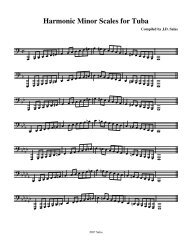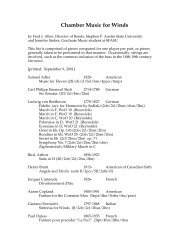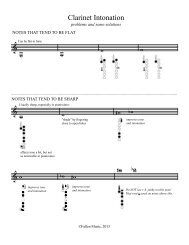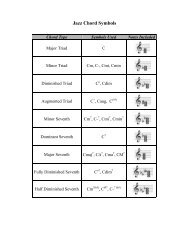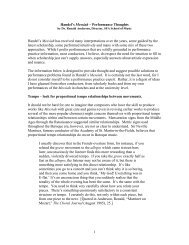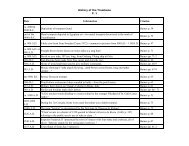You also want an ePaper? Increase the reach of your titles
YUMPU automatically turns print PDFs into web optimized ePapers that Google loves.
<strong>MUSIC</strong> <strong>THEORY</strong> <strong>QUICK</strong> <strong>FACTS</strong> <strong>SHEET</strong><br />
PART-WRITING RULES<br />
1. Allow all tendency tones to resolve correctly.<br />
2. Do not create parallel octaves, fifths, or unisons<br />
(by parallel or contrary motion).<br />
3. If it is possible to keep a note, do so, if not, move<br />
each part by the smallest possible interval. Avoid<br />
leaping by large, or difficult intervals – especially<br />
augmented intervals.<br />
4. No more than an octave between SA and AT.<br />
5. No crossed voicings or overlapping of voices.<br />
6. When there is a choice of which chord member to<br />
double, use the most stable tone present. Usually,<br />
this is the root, followed by the fifth. Never<br />
double a tendency tone as this will force you to<br />
break rule 1 or 2.<br />
7. Never omit any note of a triad or seventh chord<br />
except the fifth – and only omit the fifth when you<br />
must do so in order to follow rule 1.<br />
These principles assume that you have written with the<br />
correct ranges and that all the chords actually contain<br />
the notes you say they do.<br />
NON-CHORD TONES<br />
Type Approached By: Left By:<br />
Neighbor Tone step step in opposite direction<br />
Passing Tone step step in the same direction<br />
Appoggiatura leap step in the opposite direction<br />
Escape Tone step leap in the opposite direction<br />
Suspension same note step down<br />
Retardation same note step up<br />
Anticipation step or leap same note<br />
Pedal Tone same note same note<br />
TENDENCY TONES<br />
• The leading tone in a V or vii o chord resolves UP by step<br />
to the tonic pitch when going to I or vi.<br />
• The 7 th of any chord resolves DOWN by step.<br />
• The root of a Neapolitan chord (lowered 2 nd scale degree)<br />
resolves DOWN by diminished 3 rd to the leading tone of<br />
a V chord.<br />
• The pitches forming the augmented 6 th interval in any of<br />
the augmented sixth chords resolve outward by halfstep<br />
in both directions to the dominant pitch.<br />
• Any pitch that is altered usually resolves in the direction<br />
of its alteration.<br />
Cadence Name<br />
PAC<br />
(Perfect Authentic Cadence)<br />
IAC<br />
(Imperfect Authentic Cadence)<br />
HC<br />
(Half Cadence)<br />
PC<br />
(Plagal Cadence)<br />
DC<br />
(Deceptive Cadence)<br />
CADENCE TYPES<br />
Identifying Characteristics<br />
V or V 7 moving to I. Both chords in root position. Soprano on root of I chord.<br />
V or V 7 moving to I, but with either an inverted chord, or the soprano not finishing on<br />
the tonic.<br />
A cadence that ends on a V chord. The V chord can be approached from a number of<br />
other chords (I, ii, IV, V/V, etc.)<br />
IV moving to I. Also known as “church” cadence. Named for the “Amen” commonly<br />
used at the end of hymns.<br />
A cadence that creates the expectation of going to I, but substitutes another chord<br />
instead. Common substitutes for I are: vi, IV 6 , VI, and occasionally IV or V/ii.<br />
INVERSION SYMBOLS<br />
Root<br />
Position<br />
1 st<br />
Inv.<br />
Triad none 6<br />
Seventh<br />
Chord<br />
7<br />
6<br />
5<br />
2 nd<br />
Inv.<br />
6<br />
4<br />
4<br />
3<br />
3 rd<br />
Inv.<br />
none<br />
4<br />
2<br />
DIATONIC CHORD QUALITIES<br />
Major I ii iii IV V vi vii o<br />
vii o<br />
(VII)<br />
Minor i ii o V<br />
III iv VI<br />
(v)<br />
* In minor the V and the vii o require<br />
an accidental to raise the leading tone.<br />
FUNCTIONAL DIATONIC CHORD PROGRESSIONS<br />
Rule of Thumb<br />
Diagram of Common Functional Progressions<br />
Root<br />
movement by:<br />
Typical<br />
Direction<br />
2 nd Ascending<br />
3 rd Descending<br />
5 th Descending<br />
NUMBER OF HALFSTEPS<br />
IN SIMPLE INTERVALS<br />
Dim Min Maj Aug<br />
2 nd 0 1 2 3<br />
3 rd 2 3 4 5<br />
6 th 7 8 9 10<br />
7 th 9 10 11 12<br />
Dim Per Aug<br />
4 th 4 5 6<br />
5 th 6 7 8<br />
8 th 11 12 13
CHROMATIC CHORDS<br />
Type Notation Distinguishing Features<br />
Secondary<br />
Chord<br />
Borrowed<br />
Chord<br />
Neapolitan<br />
6 th Chord<br />
Augmented<br />
6 th Chord<br />
V/ii<br />
vii o7 /V<br />
see borrowed<br />
chord chart<br />
N 6<br />
It +6<br />
Fr +6<br />
Ger +6<br />
Any dominant-functioning chromatic chord that leads (by falling 5 th or rising halfstep root<br />
movement) to a diatonic pitch. The chord on the top can be any of the following (in any<br />
inversion): V, V 7 , vii o , vii o7 , vii ø7 . The chord on the bottom can be any diatonic or borrowed<br />
chord that is major or minor.<br />
Any chromatic triad or seventh chord that is “borrowed” from the parallel minor (or the parallel<br />
major if the original key is minor). All notes in the chord must exist in the parallel key to qualify.<br />
A major triad in first inversion with a lowered 2 nd scale degree as its root. This chord functions as<br />
a pre-dominant chord, usually coming before a V or a I 6 4.<br />
Any of three specific chords which contain the interval of an augmented sixth resolving outward<br />
by half-steps in both directions to the dominant pitch. See chart.<br />
AUGMENTED 6 TH CHORDS<br />
Example<br />
Notes Present<br />
(Key of C)<br />
Three pitches only. The<br />
It +6 characteristic augmented sixth<br />
interval, and the tonic pitch.<br />
The characteristic augmented<br />
Fr +6 sixth interval, the tonic pitch,<br />
and the second scale degree.<br />
The characteristic augmented<br />
Ger +6 sixth interval, the tonic pitch,<br />
and the lowered third (or the<br />
regular third in minor).<br />
*The “characteristic augmented sixth interval” consists of two<br />
pitches, an augmented sixth apart, that resolve outward by<br />
halfsteps to the dominant pitch.<br />
BORROWED CHORDS<br />
(Mode Mixture)<br />
Triads – Major Key<br />
Diatonic<br />
Chord<br />
I ii iii IV V vi vii o<br />
Borrowed<br />
Chord<br />
i ii o III iv v VI VII<br />
The only triads commonly borrowed in<br />
minor keys are the I and the IV<br />
Seventh Chords – Major Key<br />
Diatonic<br />
Chord<br />
I M7 ii 7 iii 7 IV M7 V 7 vi 7 vii ø7<br />
Borrowed<br />
Chord<br />
i 7 ii ø7 III M7 iv 7 v 7 VI M7 VII 7<br />
vii o7<br />
SCALES<br />
CIRCLE OF FIFTHS<br />
Major<br />
Natural<br />
Minor<br />
Harmonic<br />
Minor<br />
Melodic<br />
Minor<br />
Pentatonic<br />
Whole<br />
Tone<br />
Blues<br />
Octatonic<br />
(H-W)<br />
Octatonic<br />
(W-H)
Chord Type<br />
Bottom<br />
Interval<br />
CHORD QUALITIES<br />
Triads<br />
Top<br />
Interval<br />
Outside<br />
Interval<br />
Roman<br />
Numeral<br />
Jazz<br />
Symbol<br />
Example<br />
(key of F)<br />
Major Triad M3 m3 P5 IV B<br />
Minor Triad m3 M3 P5 vi<br />
Dm, Dmi,<br />
Dmin, D-<br />
Augmented Triad M3 M3 A5 V + C + , Caug<br />
Diminished Triad m3 m3 d5 vii o E o , Edim<br />
Chord<br />
Type<br />
Common<br />
Name<br />
Bottom<br />
Interval<br />
Seventh Chords<br />
Middle<br />
Interval<br />
Top<br />
Interval<br />
Outside<br />
Interval<br />
Roman<br />
Numeral<br />
Jazz<br />
Symbol<br />
Minor-minor 7 th Minor 7 th m3 M3 m3 m7 ii 7 Am7, Ami7,<br />
A-7<br />
Example<br />
(key of G)<br />
Major-major 7 th Major 7 th M3 m3 M3 M7 I M7 GM7, Gma7,<br />
Gmaj7, G∆7<br />
Major-minor 7 th Dominant 7 th M3 m3 m3 m7 V 7 D7<br />
Fully diminished 7 th Diminished 7 th m3 m3 m3 d7 vii o7 F# o7 ,<br />
F#dim7<br />
Half diminished 7 th Half diminished 7 th m3 m3 m3 M3 ii ø7 Am7 ( 5)<br />
Minor-major 7 th Minor-major 7 th m3 M3 M3 M7 n/a Em (maj7)<br />
Non-Chord Tones Labeled<br />
SAMPLE ANALYSIS<br />
Jazz Chords Above<br />
E B /D E E /D A /C B 7( 5) B E /G A Am 7( 5) B 7 E<br />
PT<br />
UNT<br />
SUS<br />
E : I V 6 I V 4 2/IV IV 6 Fr +6 V I 6 IV vii ø7 /V V 7 I<br />
Key Identified<br />
Roman Numerals and Figures Below<br />
HC<br />
IAC<br />
Cadences Labeled


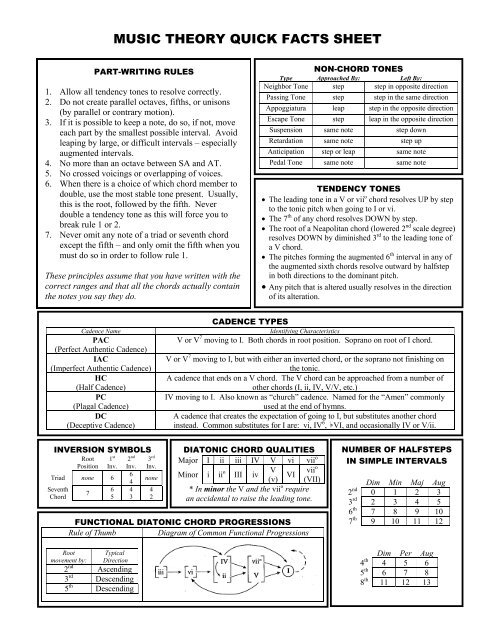
![Finale 2008 - [Whole Tone Scales - Tuba.MUS]](https://img.yumpu.com/50937649/1/190x245/finale-2008-whole-tone-scales-tubamus.jpg?quality=85)

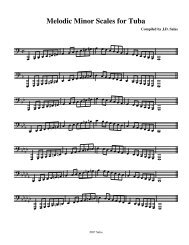
![Finale 2008 - [Chromatic Scales - Tuba.MUS]](https://img.yumpu.com/36500491/1/190x245/finale-2008-chromatic-scales-tubamus.jpg?quality=85)
